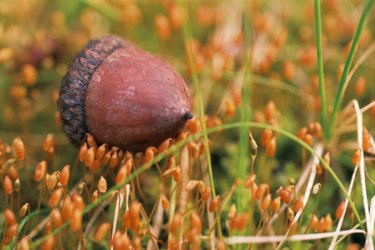
Acorns aren't just for squirrels.
You can gather them from oak trees in the fall and roast them to make a delicious snack. Acorns are actually very healthy and are rich in healthy unsaturated fats. One ounce of dried acorns contains the following, according to the USDA:
Video of the Day
Video of the Day
- 145 calories
- 8.9 g fat
- 1.2 g saturated fat
- 0 mg sodium
- 15.2 g carbs
- 2.3 g protein
However, you must prepare, treat and cook the nuts before you eat them.
Warning
Do not eat raw acorns. Raw acorns contain bitter-tasting tannins, which are toxic to humans as well as to dogs, horses and cattle, per the Woodland Trust.
Tannins, or tannic acid, are water-soluble polyphenols (plant chemicals) that are present in many plant foods and drinks, such as wine, coffee, tea, certain fruits and acorns, Katherine Brooking, RD, tells us. "However, some species of acorns contain large quantities of tannins (more than in the foods noted above)."
"High concentrations of tannins can be toxic for humans," Brooking says. "For this reason, acorns have traditionally undergone a 'leaching' process to help remove some of the tannins."
Here's how to cook acorns so that they're safe to eat, according to the Old Farmer's Almanac.
Things You'll Need
About 1 cup of acorns
Water
2 large stockpots
Wooden spoon
Colander
Paper towels
Nutcracker or clean hammer
Cookie sheet
Salt (optional)
Step 1: Select Acorns to Cook
Avoid choosing acorns with big caps, as they tend to be very bitter.
Acorns from white oak trees are typically mild and slightly sweet, while those from red or black oaks contain more tannins and are quite bitter.
Tip
Do not harvest any acorns without caps because they usually contain worms, per Redhawk's Lounge.
Step 2: Clean Your Acorns
Fill a large stockpot about 3/4 full of cool tap water. Dump the acorns into the pot.
Take out any floating acorns because these typically contain weevils or worms. Gently stir the acorns with a wooden spoon.
Pour the nuts into a colander and rinse under the tap.
Step 3: Soak the Acorns
Refill the large stockpot 3/4 full of cold tap water.
Pour the nuts into the pot and let them soak for a minimum of 1 hour to soften the shells. Drain your acorns in the colander and pat dry with paper towels.
Step 4: Shell Your Acorns
You can shell the nuts by using a nutcracker or hitting them with a clean hammer.
Separate the acorn meat from the shells. Throw out the shells and caps.
Step 5: Leach the Acorns
You'll want to leach your acorns to draw out the tannins. Bring two large stockpots to a boil. Pour the acorns into one pot and let it boil until the water turns dark, usually about 15 minutes.
Carefully transfer the acorns to the second pot of boiling water and boil the nuts for about 15 minutes. Refill the first stockpot and bring it to a boil.
Keep transferring the acorns from one pot of boiling water to the other until the water stays clear. Drain the acorns in the colander and let cool for about 10 minutes.
Warning
Do not rinse your acorns with cold water during the leaching process or you'll bind the tannins to the acorn and they will turn out bitter.
Step 6: Cook the Acorns
Preheat your oven to 350 degrees Fahrenheit. Pour the acorns into a single layer on an ungreased, rimmed cookie sheet.
Cook the nuts for about 60 minutes or until they turn a chocolate brown color.
Remove the acorns from the oven and let them cool. Salt to taste.
Tip
Mix cooked acorns with raisins or other dried fruit to make a trail mix.
You can also substitute acorns for chestnuts in baking recipes.